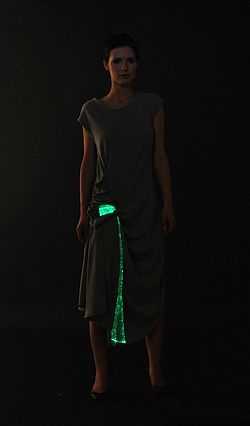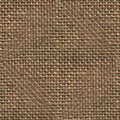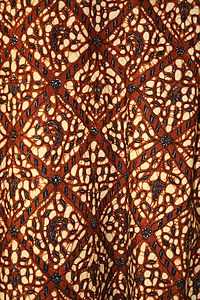E-textiles

E-textiles, also known as smart garments, smart clothing, electronic textiles, smart textiles, or smart fabrics, are fabrics that enable digital components (including small computers), and electronics to be embedded in them. Many intelligent clothing, smart clothing, wearable technology, and wearable computing projects involve the use of e-textiles.
Electronic textiles are distinct from wearable computing because emphasis is placed on the seamless integration of textiles with electronic elements like microcontrollers, sensors, and actuators. Furthermore, e-textiles need not be wearable. For instance, e-textiles are also found in interior design.
The related field of fibertronics explores how electronic and computational functionality can be integrated into textile fibers.
History
The basic materials needed to construct e-textiles, conductive threads and fabrics have been around for over 1000 years. In particular, artisans have been wrapping fine metal foils, most often gold and silver, around fabric threads for centuries.[1] Many of Queen Elizabeth I's gowns, for example, are embroidered with gold-wrapped threads. (See the entry on Goldwork for more information)
At the end of the 19th century, as people developed and grew accustomed to electric appliances, designers and engineers began to combine electricity with clothing and jewelry—developing a series of illuminated and motorized necklaces, hats, broaches and costumes.[2][3] For example, in the late 1800s, a person could hire young women adorned in light-studded evening gowns from the Electric Girl Lighting Company to provide cocktail party entertainment.[4]
In 1968, the Museum of Contemporary Craft in New York City held a groundbreaking exhibition called Body Covering that focused on the relationship between technology and apparel. The show featured astronauts’ space suits along with clothing that could inflate and deflate, light up, and heat and cool itself.[5] Particularly noteworthy in this collection was the work of Diana Dew, a designer who created a line of electronic fashion, including electroluminescent party dresses and belts that could sound alarm sirens.[6]
In 1985, an inventor by the name of Harry Wainwright (www.hleewainwright.com) created the first fully animated sweatshirt consisting of fiber optics, leds, and a microprocessor to control individual frames of animation resulting in a full color cartoon on the surface of apparel. Wainwright went on to invent the first machine in 1995 enabling fiber optics to be machined into fabrics, the process needed for manufacturing enough for mass markets and hired a German machine designer, Herbert Selbach, from Selbach Machinery to produce the world's first CNC machine able to automatically implant fiber optics into any flexible material (www.usneedle.com) in 1997. Receiving the first of a dozen patents based on LED/Optic displays and machinery in 1989, the first CNC machines went into production in 1998 beginning with the production of animated coats for Disney Parks in 1998. The first ECG Bio-Physical display jackets employing LED/Optic displays were created by Wainwright and David Bychkov, the CEO of Exmovere at he time (http://www.exmovere.com/)in 2005 using GSR sensors in a watch connected via Bluetooth to the embedded machine washable display in a denim jacket and were demonstrated at the Smart Fabrics Conference held in Washington D.C. May 7, 2007. Additional Smart Fabric technologies were unveiled by Wainwright at two Flextech Flexible Display conferences held in Phoenix, AZ, showing Infra-Red digital displays machine embedded into fabrics for IFF (Identification of Friend or Foe) which were submitted to BAE Systems for evaluation in 2006 and won an "Honorable Mention" award from NASA in 2010 on their Tech Briefs, "Design the Future" contest. MIT personnel purchased several fully animated coats for their researchers to wear at their demonstrations in 1999 to bring attention to their "Wearable Computer" research. Wainwright was commissioned to speak at the Textile and Colorists Conference in Melbourne, Australia on June 5, 2012 where he was requested to demonstrate his fabric creations that change color using any smart phone, indicate callers on mobile phones without a digital display, and contain WIFI security features that protect purses and personal items from theft.
In the mid 1990s a team of MIT researchers led by Steve Mann, Thad Starner, and Sandy Pentland began to develop what they termed wearable computers. These devices consisted of traditional computer hardware attached to and carried on the body. In response to technical, social, and design challenges faced by these researchers, another group at MIT, that included Maggie Orth and Rehmi Post, began to explore how such devices might be more gracefully integrated into clothing and other soft substrates. Among other developments, this team explored integrating digital electronics with conductive fabrics and developed a method for embroidering electronic circuits.[7][8] One of the first commercially available wearable Arduino based microcontrollers, called the Lilypad Arduino, was also created at the MIT Media Lab by Leah Buechley.
Fashion houses like CuteCircuit are utilizing e-textiles for their haute couture collections and specialty projects. CuteCircuit's Hug Shirt allows the user to send electronic hugs through sensors within the garment.
Overview
The field of e-textiles can be divided into two main categories:
- E-textiles with classical electronic devices such as conductors, integrated circuits, LEDs, and conventional batteries embedded into garments.
- E-textiles with electronics integrated directly into the textile substrates. This can include either passive electronics such as conductors and resistors or active components like transistors, diodes, and solar cells.
Most research and commercial e-textile projects are hybrids where electronic components embedded in the textile are connected to classical electronic devices or components. Some examples are touch buttons that are constructed completely in textile forms by using conducting textile weaves, which are then connected to devices such as music players[9] or LEDs that are mounted on woven conducting fiber networks to form displays.[10]
Printed sensors for both physiological and environmental monitoring have been integrated into textiles[11] including cotton,[12] Gore-Tex,[13] and neoprene.[14]
Fibretronics
Just as in classical electronics, the construction of electronic capabilities on textile fibers requires the use of conducting and semi-conducting materials such as a Conductive textile There are a number of commercial fibers today that include metallic fibers mixed with textile fibers to form conducting fibers that can be woven or sewn. However, because both metals and classical semiconductors are stiff material, they are not very suitable for textile fiber applications, since fibers are subjected to much stretch and bending during use.
one of the most important issue of E-textiles is that the fibers should be made so that it can washable as the clothes should be washed when it is dirty and the electrical components in it should be an insulator at the time of washing.
A new class of electronic materials that are more suitable for e-textiles is the class of organic electronics materials, because they can be conducting, semiconducting, and designed as inks and plastics.
Some of the most advanced functions that have been demonstrated in the lab include:
- Organic fiber transistors:[15][16] the first textile fiber transistor that is completely compatible with textile manufacturing and that contains no metals at all.
- Organic solar cells on fibers[17]
Uses
- Health monitoring of vital signs of the wearer such as heart rate, respiration rate, temperature, activity, and posture.
- Sports training data acquisition
- Monitoring personnel handling hazardous materials
- Tracking the position and status of soldiers in action
- Monitoring pilot or truck driver fatigue
- Fashion
- Regain sensory perception that was previously lost by accident or birth.
See also
- Futuristic clothing
- Identity tag
- Clothing technology
- Wearable technology
- Activity tracker
- Computer-mediated reality
- eHealth
- Heart rate monitor
References
- ↑ Harris, J., ed. Textiles, 5,000 years: an international history and illustrated survey. H.N. Abrams, New York, NY, USA, 1993.
- ↑ Marvin, C. When Old Technologies Were New: Thinking About Electric Communication in the Late Nineteenth Century. Oxford University Press, USA, 1990.
- ↑ Gere, C. and Rudoe, J. Jewellery in the Age of Queen Victoria: A Mirror to the World. British Museum Press, 2010
- ↑ http://query.nytimes.com/gst/abstract.html?res=FA0912FB3A5C15738DDDAF0A94DC405B8484F0D3
- ↑ Smith, P. Body Covering. Museum of Contemporary Crafts, the American Craft Council, New York, NY, 1968
- ↑ http://www.thecreatorsproject.com/blog/the-original-creators-diana-dew
- ↑ Post, R., Orth, M., Russo, P., and Gershenfeld, N. E-broidery: design and fabrication of textile-based computing. IBM Systems Journal 39, 3-4 (2000), 840–860.
- ↑ US 6210771 "Electrically active textiles and articles made therefrom."
- ↑ "MP3Blue.com".
- ↑ "LumaLive.com".
- ↑ "Wearable Electrochemical Sensors and Biosensors: A Review".
- ↑ "Thick-film Textile-based Amperometric Sensors and Biosensors".
- ↑ "Textile-based Electrochemical Sensing: Effect of Fabric Substrate and Detection of Nitroaromatic Explosives".
- ↑ "Wearable Electrochemical Sensors for in situ Analysis in Marine Environments".
- ↑ "Electronic Textiles: Fiber-Embedded Electrolyte-Gated Field-Effect Transistors for e-Textiles". Wiley Online Library. John Wiley & Sons, Inc. 22 January 2009.
- ↑ "Towards woven logic from organic electronic fibres". Nature Materials. Nature Publishing Group. 4 April 2007.
- ↑ "Solar Power Wires Based on Organic Photovoltaic Materials". Science. American Association for the Advancement of Science. 12 March 2009.
External links
E-textile construction kits
Research labs
- Center for Microsystem Technologies, Ghent University / IMEC, Belgium
- Advanced Textiles Research Group, Nottingham Trent University, UK
- Virginia Tech E-Textiles Lab
- XS Labs, Concordia University
- Textile Futures Program, Central St. Martins College of Art and Design
- 3lectromode Studio, Concordia University
- Wakita Lab, Keio University
- High-Low Tech Group, MIT Media Lab
- whispers research group, Simon Frasier University
- Wearable Computing Lab, ETH Zurich
- Studio subTela, Concordia University
- Laboratory for Engineered Human Protection at Philadelphia University
- Institut für Textiltechnik, RWTH Aachen
- Design Research Lab Berlin
- Fraunhofer IZM TexLab, Berlin
- Social Body Lab, OCAD University, Toronto, ON, Canada
| ||||||||||||||||||||||||||||||||||||||||||||||||||||||||||||||||||||||||||||||||||||||||||||||||||||||||||||||||||||


.svg.png)